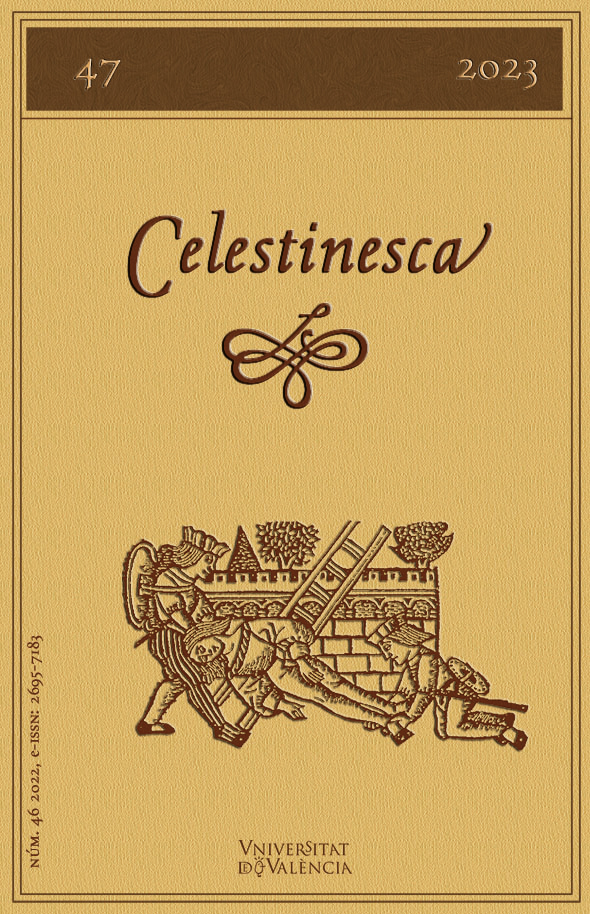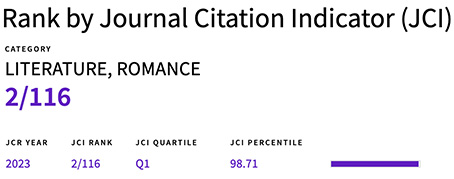Maiden, prostitute and procuress: the alternation of celestine roles in the Comedia Florinea by Rodríguez Florián (1554)
DOI:
https://doi.org/10.7203/Celestinesca.47.27230Keywords:
Comedia Florinea, prostitute, procuress, celestinesque, female characters Abstract
Abstract
In Rodríguez Florián's Comedia Florinea (1554) the story of the lovers Floriano and Belisea and the story of the lower classes are developed in parallel. The servants Fulminato, Felisino and Pinel share a close relationship with Marcelia, Liberia and Gracilia. At first glance, the protagonists of the prostibulary world might appear to be a correlate of Celestina, Elicia and Areúsa. However, none of them fulfills what is expected of their character: Marcelia, a prostitute who becomes a procuress by chance, is the one who tries to protect the honesty of her daughter Liberia. Liberia, although she maintains her virginity at the beginning of the story, is gradually corrupted throughout the Comedia, which results in her transformation into a clandestine prostitute. Gracilia is the one who pushes Liberia into prostitution and is her main ally and advisor. The female characters of the underworld present an individualisation uncommon in the Celestinesque genre. Therefore, the aim of this article is to analyse these peculiarities in order to characterise the three marginal female characters of the piece. From their statements and from the comparison with other characters of the story and of the cycle, it will be possible to determine the role played by these figures within the Florinea and in the Celestinesque genre in general. In short, the aim is to highlight the role of this work within the cycle in order to rescue it from the oblivion to which the critics have relegated it.
 Downloads
Downloads
 References
References
Alonso Hernández José Luis (1976), Léxico del marginalismo del Siglo de Oro, Salamanca, Universidad de Salamanca.
Alzieu, Pierre; Robert Jammes e Yvan Lissorgues (2000), Poesía erótica del Siglo de Oro, Barcelona, Crítica.
Baranda Leturio, Consolación (1992), "De Celestinas: problemas metodológicos", Celestinesca, 16:2, pp. 3-32. https://doi.org/10.7203/Celestinesca.16.19811
Baranda Leturio, Consolación, y Ana Vian Herrero (2007), "El nacimiento crítico del 'género' celestinesco: historia y perspectivas", en Orígenes de la novela: estudios, coord. Raquel Gutiérrez Sebastián y Borja Rodríguez Gutiérrez, Santander, Universidad de Cantabria, pp. 407-482.
Beltrán, Rafael (2018), "Sospechosas dolencias de viejas quejosas: Paltrana (Segunda Celestina), Alisa (La Celestina) y otras madres de comedia olvidadas de su obligación", Celestinesca, 42, pp. 443-476. https://doi.org/10.7203/Celestinesca.42.20234
Comedia llamada Thebayda (2021), ed. José Luis Canet Vallés, Valencia, Anejos de la revista Celestinesca.
Corominas, Joan, y José Antonio Pascual (1984), Diccionario crítico etimológico castellano e hispánico. Vol. 3, Madrid, Gredos.
Covarrubias Orozco, Sebastián de (1611), Tesoro de la lengua castellana, o española, Madrid, Luis Sánchez. http://bdh.bne.es/bnesearch/detalle/bdh0000178994# [accedido el 10/11/2023]
Delicado, Francisco (1969), La Lozana andaluza, ed. Bruno Damiani, Madrid, Castalia.
Esteban Martín, Luis Mariano (1989), "Huellas de Celestina en la Comedia Florinea y en la Comedia Selvagia", Celestinesca, 13:2, pp. 29-38. https://doi.org/10.7203/Celestinesca.13.19705
Heugas, Pierre (1973), "La Célestine" et sa descendance directe, Bordeaux, Institute d'Études Ibériques et Ibéro-Américaines de l'Université de Bordeaux.
Jauss, Hans Robert (2013), La historia de la literatura como provocación, trad. Juan Godo Costa y Jose Luis Gil Aristu, Madrid, Gredos.
Jiménez Monteserín, Miguel (1994), Sexo y bien común. Notas para la historia de la prostitución en España, Cuenca, Instituto Juan de Valdés.
Lacara, María Eugenia (1990), Cómo leer "La Celestina", Gijón, Ediciones Júcar.
Lara Alberola, Eva (2010), Hechiceras y brujas en la literatura española de los Siglos de Oro, València, Universitat de València.
López Beltrán, María Teresa (2003), La prostitución en el Reino de Granada a finales de la Edad Media, Málaga, Centro de ediciones de la Diputación de Málaga.
Menéndez Pelayo, Marcelino (1910), Orígenes de la novela IV, en Edición nacional de las obras completas de Menéndez Pelayo [digital], Biblioteca Virtual Menéndez Pelayo. https://www.larramendi.es/menendezpelayo/es/corpus/unidad.do?idCorpus=1000&idUnidad=100254&posicion=1 [accedido el 10/11/2023]
Molina Molina, Ángel Luis (1998), Mujeres públicas, mujeres secretas (La prostitución y su mundo: siglos XIII-XVII), Murcia, Editorial KR.
Moreno Mengíbar, Andrés, y Francisco Vázquez García (1995), Poder y prostitución en Sevilla (Siglos XIV al XX). I, Sevilla, Universidad de Sevilla.
Moreno Mengíbar, Andrés, y Francsico Vázquez García (2004), Historia de la prostitución en Andalucía, Sevilla, Fundación José Manuel Larra.
Muñón, Sancho de (2009), Tragicomedia de Lisandro y Roselia, ed. Rosa Navarro Durán, Madrid, Cátedra.
Pérez Pastor, Cristóbal (1895), La imprenta en Medina del Campo, Madrid, Sucesores de Rivadeneyra.
Ramos Vázquez, Isabel (2005), De meretricia turpidine. Una visión jurídica de la prostitución en la Edad Moderna castellana, Málaga, Universidad de Málaga.
Rodríguez Florián, Juan de (2000), Comedia llamada Florinea, ed. José Luis Canet, Lemir, 4, s. p. https://parnaseo.uv.es/lemir/textos/florinea/index.htm [accedido el 10/11/2023]
Rojas, Fernando de (1991), Comedia o Tragicomedia de Calisto y Melibea, ed. Peter E. Russell, Madrid, Castalia.
Silva, Feliciano de (1988), Segunda Celestina, ed. Consolación Baranda Leturio, Madrid, Cátedra.
Vives, Juan Luis (1994), Formación de la mujer cristiana = De institutione feminae christianae, ed. Joaquín Beltrán Serra, València, Ajuntament de València.
Whinnom, Keith (1988), "El género celestinesco: origen y desarrollo", en Literatura en la época del emperador, dir. Víctor García de la Concha, Salamanca, Universidad de Salamanca, pp. 119-130.
Downloads
Published
How to Cite
-
Abstract323
-
PDF (Español)343
Issue
Section
License
![]() Celestinesca is committed to the dissemination of knowledge, that is why access to its contents is free and is ruled by a Creative Commons Attribution-NonCommercial-NoDerivatives 4.0 license.
Celestinesca is committed to the dissemination of knowledge, that is why access to its contents is free and is ruled by a Creative Commons Attribution-NonCommercial-NoDerivatives 4.0 license.
Authors retain the rights to their works. Therefore, they can disseminate them and deposit them in the repository, institutional or not, that they wish. However, they are kindly requested to do so by providing the full bibliographic reference and the corresponding DOI.
Celestinesca does not charge authors for submitting, processing, reviewing or publishing their articles.





